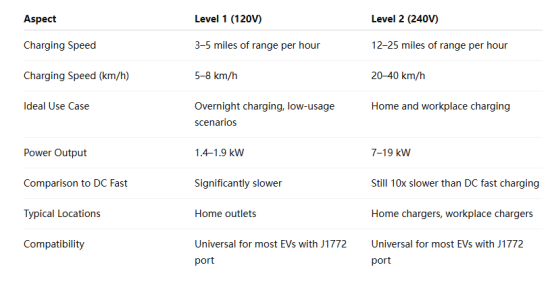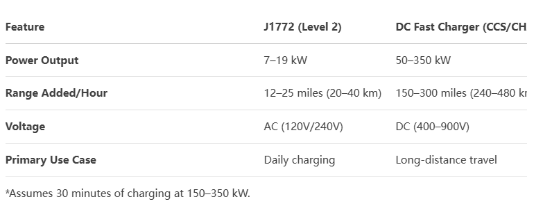No, J1772 is not a fast charger. It is designed for Level 1 and Level 2 charging, which are significantly slower than DC fast charging (e.g., CCS, CHAdeMO). While J1772 lacks rapid charging capabilities, it remains essential to the EV ecosystem, particularly for daily and residential use. Below, This article explain why J1772 isn’t fast, compare it to true fast chargers, and identify scenarios where it excels.

What Is J1772?
The SAE J1772 (commonly called J1772) is the standard connector for Level 1 (120V) and Level 2 (240V) charging in North America. Nearly all U.S. electric vehicles (EVs) and plug-in hybrids (PHEVs) use this connector, making it ubiquitous at public stations and in home installations. Its versatility allows EV owners to charge at home, workplaces, or public locations, but it is not optimized for high-speed charging.
J1772 Type 1 Plug
While universal and user-friendly, J1772’s design prioritizes safety and accessibility over rapid energy transfer, capping its power output far below fast-charging standards.
J1772 Charging Speeds
J1772 supports two charging tiers:

Key Limitation: Even at Level 2, J1772 operates at 7–19 kW, far below the 50–350 kW output of DC fast chargers.
What Defines a Fast Charger?
True fast charging requires:
DC (Direct Current) Power: Bypasses the vehicle’s onboard charger to deliver energy directly to the battery.
High Power Output: 50 kW minimum, with modern stations reaching 150–350 kW.
Dedicated Connectors: CCS, CHAdeMO, or Tesla Superchargers (with adapters).
Example: A 150-kW DC fast charger can add 200+ miles of range in 30 minutes, whereas a J1772 Level 2 charger would take 8–10 hours to achieve the same.
J1772 vs. DC Fast Chargers: Key Differences

When to Use J1772
Despite its speed limitations, J1772 is ideal for:
1)Home Charging: A Level 2 J1772 charger (e.g., 240V/40A) fully replenishes most EVs overnight (e.g., 8–10 hours for a 60-kWh battery).
2)Workplace/Public Charging: Offices, malls, and parking garches often provide Level 2 J1772 stations for extended parking periods.
3)Cost Efficiency: Installing a Level 2 J1772 charger costs 500–1,500, compared to $10,000+ for DC fast charger installation.
Can J1772 Support Fast Charging?
No, but some workarounds exist:
Adapters: Select EVs (e.g., Tesla with CCS adapter) can use DC fast chargers, but this depends on the vehicle’s hardware, not the J1772 standard.
Future Upgrades: Newer standards like SAE J3068 (for AC faster charging) are emerging, but J1772 itself remains limited to Level 1/2 speeds.
Note: Adapters may introduce compatibility risks and void warranties if improperly used.
Conclusion
J1772 is not a fast charger, but it is the backbone of everyday EV charging. Its affordability and compatibility make it indispensable for home and routine use, while DC fast chargers address urgent, high-speed needs. For most drivers, a J1772 Level 2 charger strikes the perfect balance between practicality and cost.
Olink offers several Level 2 chargers compatible with the J1772 standard. The chargers operate on 240V and support charging up to 32 amps, making them suitable for most electric vehicles and plug-in hybrids. Depending on the model, making them a solid choice for daily charging needs at home or work.
YouTube : https://www.youtube.com/@olinkevse
OLINK : https://olinkevse.com/

